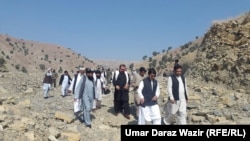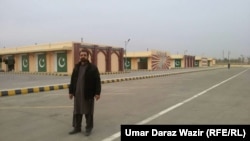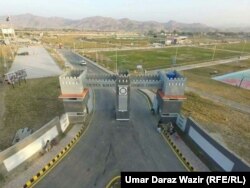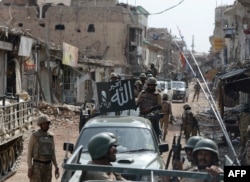BANNU, Pakistan -- Nisar Ali Khan, a middle-aged Pashtun politician in Pakistan, is lucky to have survived multiple attempts on his life by some of the world’s most dangerous militants.
Khan, a lanky figure sporting a salt-and-pepper beard, is a prominent leader of the secular Awami National Party in North Waziristan. He has survived numerous assassination attempts over three years, beginning in 2008 in his mountainous homeland, a tribal district in northwestern Pakistan.
He first faced the brunt of Al-Qaeda, the Taliban’s military arm the Haqqani network, and allied jihadists who counted North Waziristan as their global headquarters after he followed his party’s line and publicly opposed their presence in his homeland.
“In the years following the attacks of Sept. 11, 2001, Waziristan was in complete darkness,” he recalled.“Militants operating under the name of the Taliban and other organizations were able to get away with everything.”
Before he became a top militant target, Khan saw many North Waziristan residents accused of spying and killed. He lost several close friends. “Some were the victims of targeted assassination attacks, while others were just unlucky and killed in random [bomb] attacks,” he said.
Khan, who wears a traditional gold-colored turban, received daily threats after he decided to run for parliament in early 2008. “Every time I left my house, I felt like a walking dead man,” he said. “Returning home was always a relief.”
While campaigning in February 2008, he survived a suicide bombing near Mir Ali, a major town in North Waziristan. The blast killed his eight companions and left shrapnel in his shoulders.
In the following months, his family’s business, a modest shop in Eidak, a large village near Mir Ali, was burned to ashes. When that didn’t stop Khan from speaking out against the militants, a bomb blew up the front gate of his fortress-like mud house.
“The terrorists won’t stop at anything. They bombed the shop after we rebuilt it, and when that didn’t work they fired two rockets to destroy it,” he said.
His petitions for protection from the government fell on deaf ears as most officials were sheltered in heavily fortified military camps and only moved in convoys protected by soldiers.
In October 2010, Khan was kidnapped by militants. After nearly two months of torture, they set him free but killed his close friend Fazal Hamid Dawar.
For the next three and a half years, Khan remained underground. He emerged from hiding when he felt the hour of reckoning for his tormentors had arrived.
In June 2014, Pakistan launched an all-out offensive in North Waziristan.
But his ordeal didn’t end there. The authorities gave his family and fellow tribespeople, members of the Dawar and Wazir clans, just three days to leave North Waziristan before launching Zarb-e Azab, the formal name of the offensive. The operation relied on air strikes, artillery barrages, and conventional sweeps.
Khan recently visited North Waziristan to gauge the prospects of his return, and he says he is optimistic. “We don’t have 100 percent peace in North Waziristan, but there is a fragile peace, and development projects are under way,” he said.
In scores of interviews, Waziristan civilians share his optimism. They say the region is now militant-free and a tenuous peace has returned to towns and villages where civilians were tormented by suicide bombings and assassinations, Pakistani military counterterrorism sweeps, and U.S. drone strikes targeting militant leaders.
But their suffering largely remained invisible because North Waziristan and the six neighboring districts in the Federally Administered Tribal Areas (FATA) remained off limits to news media and aid workers.
Journalist Qadeer Dawar says returning to Waziristan after two years in exile in neighboring Bannu feels like surviving a massive earthquake. This district in Pakistan’s northwestern Khyber Pakhtunkhwa Province has housed more than 1 million displaced North Waziristan residents.
Dawar says that for the nearly 10 years (from 2004 to 2014) that his homeland was effectively run by militants and the government, all development, business, and education ceased. During that time, more than 50,000 Pakistani civilians and soldiers were killed in militant attacks across the country. Many were traced to North Waziristan, where the leadership of various groups was holed up.
“Now everything has changed. We have peace, and the entire government machinery is back up and running,” he said of recent trips to Mir Ali and Miran Shah, the administrative headquarters of North Waziristan. “Most of our schools are working, we have brand-new roads, and the military has built water-supply infrastructure.”
Islamabad is keen to showcase its achievements in North Waziristan because for more than a decade, Afghanistan and its Western allies demanded that Pakistan end terrorist sanctuaries in the region.
Kabul has blamed the Haqqani network for complex urban attacks targeting embassies and government and international troops. Some terrorist attacks and plots in Europe and North America were traced back to the Al-Qaeda cells in North Waziristan. The region was the scene of some 280 U.S. drone attacks that killed numerous militant leaders and some civilians, according to data compiled by the Long War Journal website.
The Pakistani Army, which still keeps tens of thousands of soldiers in the region, is now taking the lead in rehabilitating North Waziristan. With the help of the U.S. Agency for International Development and Gulf donors, it completed several major roads, stadiums, markets, hospitals, schools, colleges, and irrigation projects before welcoming the return of an estimated 1.5 million displaced Waziristanis.
In a major step toward reviving the local economy, Islamabad also announced the reopening of a major trade route. Waziristan traders say the looming resumption of trade and transport links with the southeastern Afghan province of Khost through the remote Ghulam Khan border crossing will restore local jobs and businesses.
North Waziristan’s administration says it has paid $2 million in claims to some 700 homeowners whose properties were destroyed or damaged.
In Bannu, the government registered more than 84,000 displaced families after the mass exodus from Waziristan, more than 60,000 of whom have now returned. Officials say they are working on bringing 24,000 families back from Bannu while also looking into helping another 7,500 families in Khost.
As the political agent or most senior civilian bureaucrat, Kamran Afridi has his finger on the pulse of North Waziristan. He acknowledges its problems but says he sees the region as being on a positive trajectory.
“We have completely stopped terrorist violence. Everyone can now move freely without carrying arms in North Waziristan,” he said. “Sporadic attacks and occasional security incidents can happen anywhere. Even those are mostly because of local feuds.”
He is keen to jump-start the local economy and cites a need to bring North Waziristan and the rest of FATA on par with the more developed regions of Pakistan.
“FATA is no different than other parts of Pakistan, and it can’t be stopped from matching them,” he said. “But the state needs to focus on working here so this region can be self-sustainable in addressing new challenges.”
Rozina Akhatar, a female aid worker from Mir Ali, senses a change in the worldview of many Waziristanis who are eager to embrace peace and prosperity.
She says that as a measure of changing outlooks, most women now want to send their kids to school. This is remarkable given that female literacy levels in Waziristan remain in the single digits.
“Everyone now realizes how valuable peace is,” she said. “They are more aware of their rights. Exile has opened their eyes to the opportunities only education can help them attain.”
Khan, however, says resentment over Islamabad’s willingness or inability to properly rehabilitate Waziristan residents will fuel resentment that extremists could potentially exploit.
Islamabad now pays a meager $4,000 to those who houses were completely destroyed. Owners of partially damaged houses get $1,600. Locals say the amount is not enough to rebuild a single room, let alone a large mud house. Houses in Waziristan typically consist of large compounds surrounded by high walls containing rows of rooms and verandas. Building them requires years of hard labor and tens of thousands of dollars.
“If our people are unhappy about what they are getting after so much suffering, this entire antiterrorism effort will be squandered,” he said. “In addition, the government needs to swiftly deal with some of the terrorists lurking along the Afghanistan-Pakistan border. Only then can we really begin a journey toward peace and prosperity.”
Political activist Rahmanullah Wazir says North Waziristan’s fate can only change if Islamabad commits to long-lasting political reforms in FATA.
Wazir is part of a political alliance that has long advocated the repeal of FATA’s draconian colonial-era legal regime and is urging Islamabad to absorb the region into the political, legal, and administrative mainstream so that its residents may enjoy all the citizenship rights enshrined in the Pakistani Constitution.
“We still don’t have the freedom of assembly. Even holding our traditional jirgas (council of elders) is not possible.” he said.
Wazir says Islamabad needs to swiftly implement such reforms to mitigate historic grievances in FATA.
“When Pakistan needs us, it always gives us a pat on our backs and says, ‘You are the bravest of all -- pick this gun and fight for us’,” he said, describing Islamabad’s exploitation of the warrior image of FATA Pashtuns. “But when it comes to our rights, it denies us our basic rights or even the legal recourse to press for them.”
Wazir says he now sees a ray of hope but feels the lot of long-suffering Waziristanis has fundamentally not improved yet.
“We are treated a lot worse than members of other ethnicities in Pakistan,” he said.
fg/














